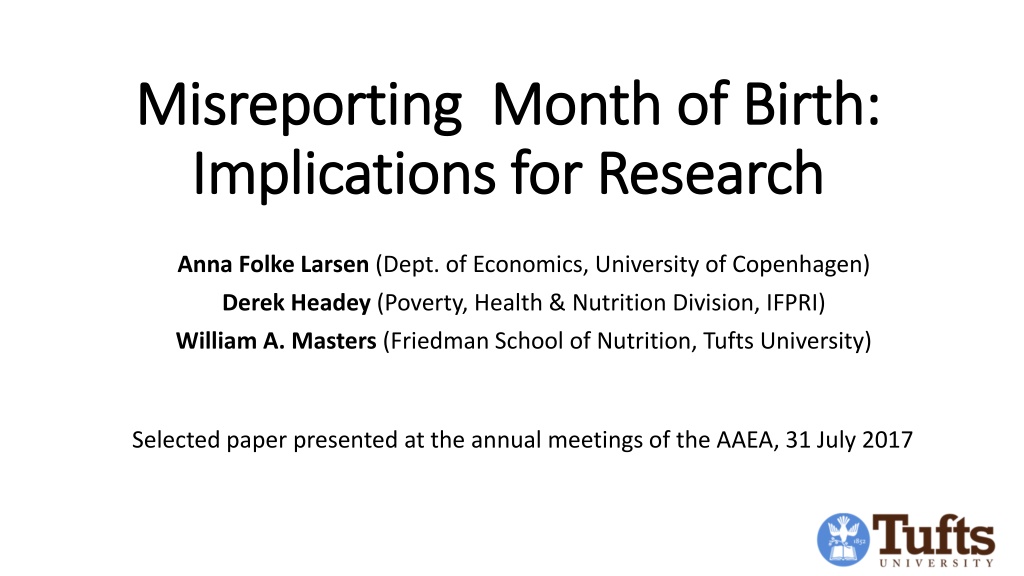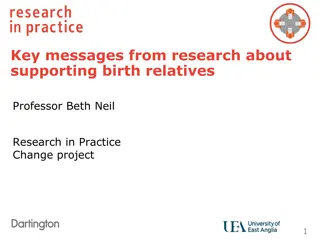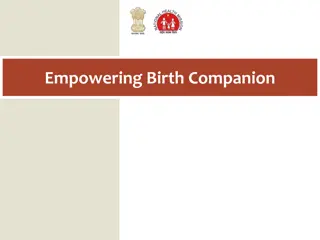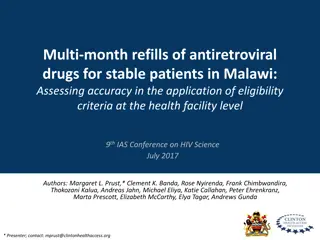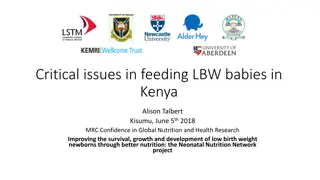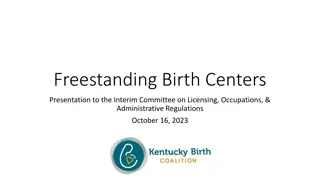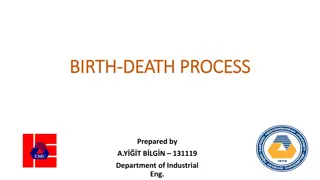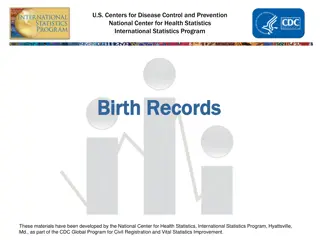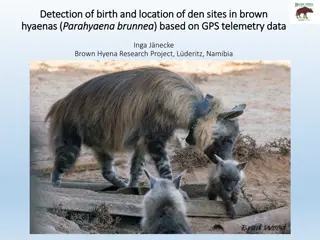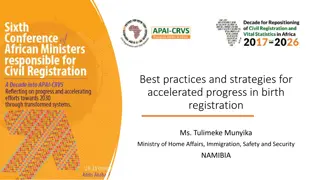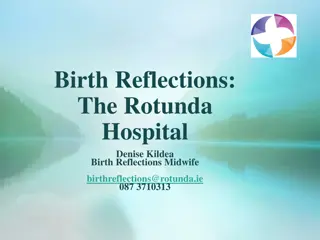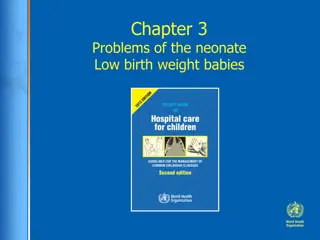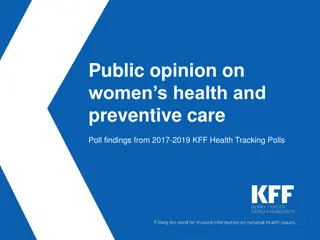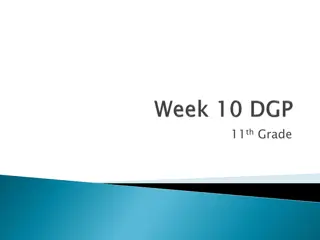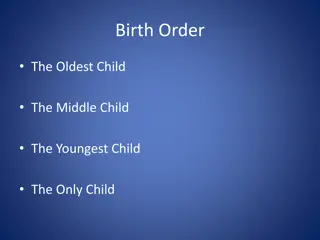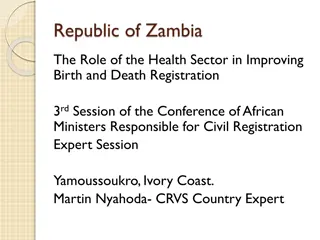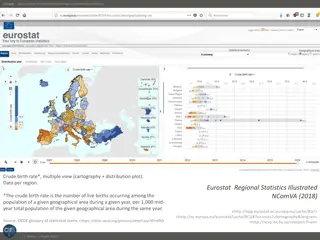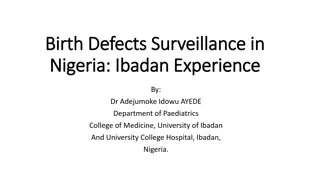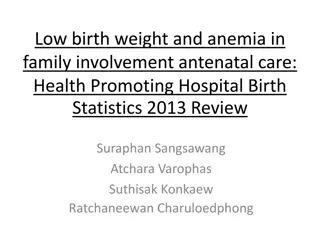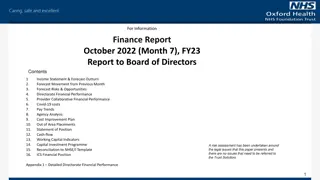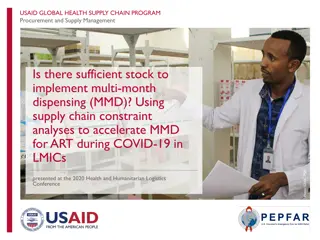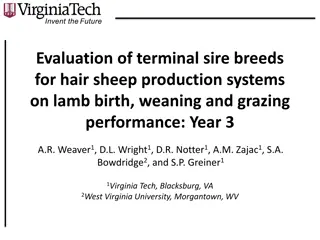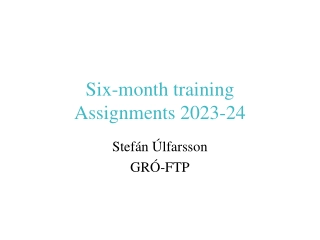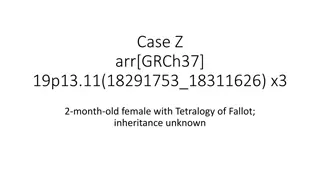Understanding Misreporting of Month of Birth in Research
Researchers discuss the implications of misreporting the month of birth in studies on how exposure to agro-environmental and other shocks in early life affects lifelong health outcomes. They analyze patterns of seasonality and anomalies in reported birth months, highlighting the impact on child growth measurements. The study reveals systematic errors in reporting children's ages, proposing a model to adjust for these anomalies and ensure accurate data analysis in research.
Download Presentation

Please find below an Image/Link to download the presentation.
The content on the website is provided AS IS for your information and personal use only. It may not be sold, licensed, or shared on other websites without obtaining consent from the author. Download presentation by click this link. If you encounter any issues during the download, it is possible that the publisher has removed the file from their server.
E N D
Presentation Transcript
Misreporting Misreporting Month of Birth: Month of Birth: Implications for Research Implications for Research Anna Folke Larsen (Dept. of Economics, University of Copenhagen) Derek Headey (Poverty, Health & Nutrition Division, IFPRI) William A. Masters (Friedman School of Nutrition, Tufts University) Selected paper presented at the annual meetings of the AAEA, 31 July 2017
Motivation Exposure to agro-environmental and other shocks in utero and infancy has lifelong consequences for health, human capital and productivity Health outcomes are often measured by attained height Heights can be measured quickly and non-invasively, during an interview Potential heights vary for individuals but not for (most) populations Population heights are sensitive to shocks, especially if experienced before age 2 Population heights in childhood predict many later outcomes We find strong patterns of seasonality, with poor outcomes for children born at bad times (e.g. monsoons, droughts, Ramadan, lean seasons etc.)
The puzzle Also, this: We stumbled on this: What could have caused these patterns? Previous work focuses on heaping, but we find gradients and gaps Source: Note: DHS data for 990,231 children from 62 countries, various years. Data shown are mean height-for-age z-scores (HAZ) by month of birth (MOB). Vertical bars indicate standard errors of the mean HAZ.
The puzzle The January-December gradient (and Dec-Jan gap) arises in diverse regions: and the pattern differs where calendars differ: Data shown are mean height-for-age z-scores (HAZ) by month of birth (MOB). Vertical bars indicate standard errors of the mean HAZ.
Childrens age is subject to systematic errors Roughly same number of births each calendar month among infants After first year, reported birthdays have clear artifacts Source: DHS data for 990,231 children from 62 countries, various years. Note: Data shown are fraction of children at each age, with birth date in months prior to the survey date.
Can we explain the anomaly, and adjust for it? We can use child growth as a biological clock, to detect systematic errors MOB within calendar years from Jan to Dec, hence a Dec-Jan gap in heights Months past completed years from 1 to 11, hence an end-start gap in heights To explain the anomaly, we use a novel model of MOB error we simulate DHS data to replicate the anomaly as an artifact of these errors we use actual DHS data to test where and when the anomaly is largest we use the estimated extent of error to derive corrected stunting rates
Summary of results Calendar year anomalies can be replicated with random month of birth The Dec-Jan gap is 0.32 HAZ points, over the entire DHS sample (990,231 children) That could be explained by 11% of children having randomly assigned birth months This kind of error expands the tails of HAZ distribution, causing: 0.5 percentage points increase in stunting (HAZ < -2) 0.7 percentage points increase in severe stunting (HAZ -3) The completed-year anomaly is harder to replicate and correct The end-start gap is always confounded by actual aging, so cannot be estimated But this kind of error would systematically understate age and overstates HAZ level, offsetting any effect of MOB error on stunting rates The Dec-Jan gap can be used to detect errors in age reporting When using existing surveys in studies of seasonality or early life shocks While conducting new surveys to improve data quality
Statistical controls cant solve the problem None of Dec-Jan gap is explained by covariates About half of round-age gap is explained by actual child aging m1: MOB anomalies without other controls m2: adds controls for child sex, age, age-squared and survey fixed effects m3: adds household assets, parental education, total number of children, total number of adults, toilet availability, water source and rural location
Actual data have a clearer problem than imputed data The anomalous gradient from Jan to Dec is clear in the actual data, and not caused by imputation Imputed data is much more random m1: MOB anomalies without other controls m2: adds controls for child sex, age, age-squared and survey fixed effects m3: adds household assets, parental education, total number of children, total number of adults, toilet availability, water source and rural location
Literacy is associated with a smaller anomaly Literate mothers have a smaller gradient m1: MOB anomalies without other controls m2: adds controls for child sex, age, age-squared and survey fixed effects m3: adds household assets, parental education, total number of children, total number of adults, toilet availability, water source and rural location
What about birth records? Having a birth certificate helps When enumerators see the certificate, the anomaly almost disappears m1: MOB anomalies without other controls m2: adds controls for child sex, age, age-squared and survey fixed effects m3: adds household assets, parental education, total number of children, total number of adults, toilet availability, water source and rural location
We can replicate the anomaly by introducing purely random MOBs With 0% random, there is no MOB effect With 11% random, we replicate the actual gap of 0.3 HAZ points
How does random MOB leave a nonrandom trace? When random scrambling occurs within years, kids whose recorded MOB is late in the year may be older than reported Those with recorded MOB early in the year may be younger than reported Some of these kids were actually born in earlier months, so they re older than reported (and not actually this tall for their age) Some of these kids were actually born in later months, so they re younger than reported (and not actually so short for their age) Data shown are mean height-for-age z-scores (HAZ) by month of birth (MOB), across all DHS surveys (990,231 children from 62 countries, various years). Vertical bars indicate standard errors of the mean HAZ.
In summary Calendar year anomalies can be replicated with random month of birth The Dec-Jan gap is 0.32 HAZ points, over the entire DHS sample (990,231 children) That could be explained by 11% of children having randomly assigned birth months This kind of error expands the tails of HAZ distribution, causing: 0.5 percentage points increase in stunting (HAZ < -2) 0.7 percentage points increase in severe stunting (HAZ -3) The completed-year anomaly is harder to replicate and correct The end-start gap is always confounded by actual aging, so cannot be estimated But this kind of error would systematically understate age and overstates HAZ level, offsetting any effect of MOB error on stunting rates The Dec-Jan gap can be used to detect errors in age reporting Before using existing surveys in studies of seasonality or early life shocks While conducting new surveys to improve data quality
Thank you! Contact details: Anna Folke Larsen, Univ. of Copenhagen (afl@econ.ku.dk) Derek Headey, IFPRI (d.headey@cgiar.org) Will Masters, Tufts (william.masters@tufts.edu) Funding: IFPRI: Bill & Melinda Gates Foundation, for Advancing Research on Nutrition and Agriculture (ARENA) at IFPRI Tufts: Feed the Future Innovation Lab for Nutrition (USAID grant AID- OAA-L-1-00005) and the Feed the Future Policy Impact Study Consortium (USDA cooperative agreement TA-CA-15-008). Copenhagen: Danish Council for Independent Research
